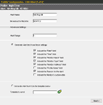

The Network Broadcast Alert causes a Win Popup on the desktop of a specified network machine or on the local desktop. It supports passing Tokens to define the Event string.
| Prompt |
Comment |
| Notifier Name: |
Notifier Name (optional) is the user-defined name of the Alert. |
| Broadcast to Machine: |
The User/Machine name (optional) of the remote computer to which the message will be sent (no double backslashes allowed). A blank string specifies the local computer. |
| Alert Parameters: |
Alert Parameters determine what details will be reported in the Alert String.
- Alert Range: Configurable Alert Ranges make it possible to receive all possible alerts notifications or only some of them.
- Generate Alert text from these settings - Frequently used tokens can easily selected using radio buttons.
- Generate Alert text from the template below - Alert strings can be concatenated using all possible Alert tokens. Select the "?" help icon to display a list of all tokens.
|
Notes regarding NT Event Log Alerts
- "Notifier Name" is simply for organization of the configured content. It doesn't have anything to do with binding Alerts to Profiles. Multiple alerts can have the same name without interfering with each other.
- "Alert Range" makes it possible to select which triggered Alerts will be acted on. For example, a senior administrator might be Alerted only if the event is not handled in a timely manner by someone else. By default the value of 1- is supplied (note, no terminating number), meaning email will be sent the first Alert and all subsequent Alerts. Ranges work in exactly the same manner that printing ranges work in Microsoft Word. 1-3 would Alert 1st, 2nd & 3rd Alerts. 1,2,4 would Alert 1st, 2nd & 4th Alerts, skipping the 3rd. 1-3,6-9 would Alert 1st through 3rd, then skip 4th & 5th and resume alerting for 6th through 9th.
- "Tokens" can be placed between alphanumeric characters, words, or sentences. When a Token is found, it is replaced with dynamic content represented by the token. Tokens are shown below.
| Tokens |
|
| %% |
a single "%" |
| %D |
date (YYYY-MM-DD) |
| %T |
time (HH:MM:SS) |
| %a |
Monitor: address field (short format) |
| %A |
Monitor: address field (long format) |
| %b |
Monitor: status (1 for UP, 0 for down) |
| %s |
Monitor: status full text |
| %t |
Monitor: type |
| %i |
Monitor: internal ID |
| %n |
Monitor: name |
| %c |
Monitor: comment |
| %f |
Monitor: frequency |
| %F |
Monitor: error frequency |
| %N |
Monitor: notify failures |
| %m |
Monitor: maximum duration |
| %M |
Monitor: maximum alerts |
| %S |
Monitor: number of alerts sent |
| %x |
Monitor: continuous failures |
| %X |
Monitor: continuous critical failures |
| %p |
Profile: name |
| %P |
Alert: name |
| %qa |
SNMP Trap: IP address from last Trap received |
| %qb |
SNMP Trap: Specific Trap identifier from the last Trap (applies to
Enterprise specific Traps only) |
| %qc |
SNMP Trap: Community from the last Trap |
| %qd |
SNMP Trap: Textual description of the Trap from the last Trap:
"Cold Start", "Warm Start", "Link Down", "Link Up",
"Authentication Failure", "egp Neighbor Loss",
"Enterprise Specific" |
| %qe |
SNMP Trap: Enterprise used for the last Trap |
example:
[%D %T] %n: "%s"
[1998-11-05 4:20:00] WWW @ MH: "Connect failed"
|
